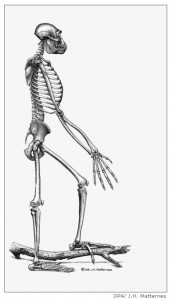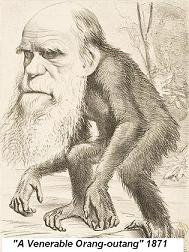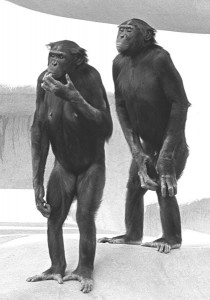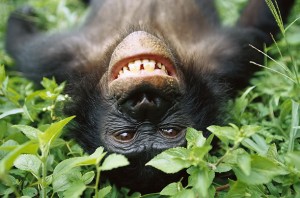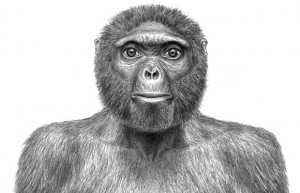
This website was created to help students of paleoanthropology and to also give them the pool of data and general information needed to come to a fuller understanding of human evolution.
In biology, evolution is the process by which populations of organisms acquire and pass on novel traits from generation to generation, affecting the overall makeup of the population and even leading to the emergence of new species. The terms organic evolution or biological evolution are often used to distinguish this meaning from other usages.
The development of the modern theory of evolution began with the introduction of the concept of natural selection in a joint 1858 paper by Charles Darwin and Alfred Russel Wallace. This theory achieved a wider readership in Darwin’s 1859 book, The Origin of Species.
Darwin and Wallace proposed that evolution occurs because a heritable trait that increases an individual’s chance of successfully reproducing will become more common, by inheritance, from one generation to the next, and likewise a heritable trait that decreases an individual’s chance of reproducing will become rarer. This work was groundbreaking and overturned other evolutionary theories, such as that advanced by Jean Baptiste Lamarck.
In the 1930s, scientists combined Darwinian natural selection with the re-discovered theory of Mendelian heredity to create the modern synthesis, now one of the fundamental scientific theories of biology. In the modern synthesis, “evolution” is defined as a change in the frequency of alleles within a population from one generation to the next. This change may be caused by different mechanisms, including natural selection, genetic drift, or changes in population structure (gene flow).
The theory underlying modern synthesis has three major aspects:
The common descent of all organisms from a single ancestor or ancestral gene pool. The manifestation of novel traits in a lineage. The mechanisms that cause some traits to persist while others perish. The modern synthesis, like its Mendelian and Darwinian antecedents, is a scientific theory. In plain English, people use the word “theory” to signify “conjecture”, “speculation”, or “opinion”.
In this popular sense, “theories” are opposed to “facts” parts of the world, or claims about the world, that are real or true regardless of what people think. In contrast, a theory is a model of the world (or some portion of it) from which falsifiable hypotheses can be generated and tested through controlled experiments, or be verified through empirical observation. In this scientific sense, “facts” are parts of theories they are things, or relationships between things, that theories must take for granted in order to make predictions, or that theories predict.
In other words, for scientists “theory” and “fact” do not stand in opposition, but rather exist in a reciprocal relationship, for example, it is a “fact” that an apple dropped on earth will fall towards the centre of the planet in a straight line, and the “theory” which explains it is the current theory of gravitation. In this same sense evolution is a fact and modern synthesis is currently the most powerful theory explaining evolution, variation and speciation.
Within the science of biology, the modern synthesis has completely replaced earlier accepted explanations for the origin of species, including Lamarckism and creationism.
Ancestry of organisms
In biology, the theory of universal common descent proposes that all organisms on Earth are descended from a common ancestor or ancestral gene pool (which is called having “common descent”).
Evidence for common descent may be found in traits shared between all living organisms. In Darwin’s day, the evidence of shared traits was based solely on visible observation of morphologic similarities, such as the fact that all birds even those which do not fly have wings. Today, the theory of evolution has been strongly confirmed by genetics. For example, every living thing makes use of nucleic acids as its genetic material and uses the same twenty amino acids as the building blocks for proteins. All organisms use the same genetic code (with some extremely rare and minor deviations) to translate nucleic acid sequences into proteins. Because the selection of these traits is somewhat arbitrary, their universality strongly suggests common ancestry.
The evolutionary process can be exceedingly slow. Fossil evidence indicates that the diversity and complexity of modern life has developed over much of the age of the earth. Geological evidence indicates that the Earth is approximately 4.6 billion years old. (See Timeline of evolution.)
Studies on guppies [2] by David Reznick at the University of California, Riverside, however, have shown that evolutionary rates in the wild can proceed 10 thousand to 10 million times faster than what is indicated in the fossil record.
Information about the early development of life includes input from the fields of geology and planetary science. These sciences provide information about the history of the Earth and the changes produced by life. A great deal of information about the early Earth has been destroyed by geological processes over the course of time.
Evidence of evolution and Morphological evidence
Fossils are important for estimating when various lineages developed. As fossilization is an uncommon occurrence, usually requiring hard parts (like bone) and death near a site where sediments are being deposited, the fossil record only provides sparse and intermittent information about the evolution of life. Fossil evidence of organisms without hard body parts, such as shell, bone, and teeth, is sparse but exists in the form of ancient microfossils and the fossilization of ancient burrows and a few soft-bodied organisms.
Fossil evidence of prehistoric organisms has been found all over the Earth. The age of fossils can often be deduced from the geologic context in which they are found, and their absolute age can be verified with radiometric dating. Some fossils bear a resemblance to organisms alive today, while others are radically different. Fossils have been used to determine at what time a lineage developed, and transitional fossils can be used to demonstrate continuity between two different lineages. Palaeontologists investigate evolution largely through analysis of fossils.
Phylogeny, the study of the ancestry of species, has revealed that structures with similar internal organization may perform divergent functions. Vertebrate limbs are a common example of such homologous structures. A vestigial organ or structure may exist with little or no purpose in one organism, though they have a clear purpose in others. The human wisdom teeth and appendix are common examples.
Genetic sequence evidence
Comparison of the genetic sequence of organisms reveals that phylogenetically close organisms have a higher degree of sequence similarity than organisms that are phylogenetically distant. For example, neutral human DNA sequences are approximately 1.2% divergent (based on substitutions) from those of their nearest genetic relative, the chimpanzee, 1.6% from gorillas [3], and 6.6% from baboons[4]. Sequence comparison is considered a measure robust enough to be used to correct mistakes in the phylogenetic tree in instances where other evidence is scarce.
Further evidence for common descent comes from genetic detritus such as pseudogenes, regions of DNA which are orthologous to a gene in a related organism, but are no longer active and appear to be undergoing a steady process of degeneration[5].
Since metabolic processes do not leave fossils, research into the evolution of the basic cellular processes is done largely by comparison of existing organisms. Many lineages diverged at different stages of development, so it is theoretically possible to determine when certain metabolic processes appeared by comparing the traits of the descendants of a common ancestor.
Origin and history of life
Not much is known about the earliest development of life. However, all existing organisms share certain traits, including cellular structure, and genetic code. Most scientists interpret this to mean all existing organisms share a common ancestor, which had already developed the most fundamental cellular processes, but there is no scientific consensus on the relationship of the three domains of life (Archea, Bacteria, Eukaryota) or the origin of life. Attempts to shed light on the earliest history of life generally focus on the behaviour of macromolecules, particularly RNA, and the behaviour of complex systems.
Though the origins of life are murky, other milestones in the evolutionary history of life are well known. The emergence of oxygenic photosynthesis (around 3 billion years ago) and the subsequent emergence of an oxygen-rich, non-reducing atmosphere can be traced through the formation of banded iron deposits, and later red beds of iron oxides. This was a necessary prerequisite for the development of aerobic cellular respiration, believed to have emerged around 2 billion years ago.
In the last billion years, simple multicellular plants and animals began to appear in the oceans. Soon after the emergence of the first animals, the Cambrian explosion (a period of unrivaled and remarkable, but brief, organismal diversity documented in the fossils found at the Burgess Shale) saw the creation of all the major body plans, or phyla, of modern animals.
This event is now believed to have been triggered by the development of Hox genes. About 500 million years ago, plants and fungi colonized the land and were soon followed by arthropods and other animals, leading to the development of land ecosystems with which we are familiar.
Emergence of novel traits
Mutation
Darwin did not know the source of variations in individual organisms but observed that it seemed to be by chance. Later work pinned much of this variation onto mutations. Mutations are permanent, transmissible changes to the genetic material (usually DNA or RNA) of a cell, and can be caused by “copying errors” in the genetic material during cell division and by exposure to radiation, chemicals, or viruses.
In multicellular organisms, mutations can be subdivided into germline mutations, which can be passed on to progeny and somatic mutations, which (when accidental) often lead to the malfunction or death of a cell and can cause cancer. Mutations serve to introduce novel genetic variation which may affect the fitness of the organism.
Survival of traits
Mechanisms of inheritance
In Darwin’s time, scientists did not share broad agreement on how traits were inherited. Today most inherited traits are traced to discrete, persistent entities called genes, encoded in linear molecules called DNA. Though largely faithfully maintained, DNA is both variable across individuals and subject to a process of change or mutation (described above).
However, other non-DNA based forms of heritable variation exist. The processes that produce these variations leave the genetic information intact and are often reversible. This is called epigenetic inheritance and may include phenomena such as DNA methylation, prions, and structural inheritance. Investigations continue into whether these mechanisms allow for the production of specific beneficial heritable variation in response to environmental signals. If this were shown to be the case, then some instances of evolution would lie outside of the typical Darwinian framework, which avoids any connection between environmental signals and the production of heritable variation.
There are factors that influence the frequency of existing alleles. These factors mean that some characteristics will become more frequent while others diminish or are lost entirely. There are three known processes that affect the survival of a characteristic (or, more specifically, the frequency of an allele):
- Natural selection
- Gene flow
- Genetic drift
- Natural selection
Natural selection comes from differences in survival and reproduction as a result of the environment. Differential mortality is the survival rate of individuals to their reproductive age. Differential fertility is the total genetic contribution to the next generation.
Note that, whereas mutations and genetic drift are random, natural selection is not, as it preferentially selects for different mutations based on differential fitnesses. For example, rolling dice is random, but always picking the higher number on two rolled dice is not random. The central role of natural selection in evolutionary theory has given rise to a strong connection between that field and the study of ecology.
Natural selection can be subdivided into two categories:
Ecological selection occurs when organisms that survive and reproduce increase the frequency of their genes in the gene pool over those that do not survive.
Sexual selection occurs when organisms which are more attractive to the opposite sex because of their features reproduce more and thus increase the frequency of those features in the gene pool.
Natural selection also operates on mutations in several different ways:
Purifying or background selection eliminates deleterious mutations from a population.
Positive selection increases the frequency of a beneficial mutation. Balancing selection maintains variation within a population through a number of mechanisms, including:
Overdominance or heterozygote advantage, where the heterozygote is more fit than either of the homozygous forms (exemplified by human sickle cell anaemia conferring resistance to malaria)
Frequency-dependent selection, where the rare variants have higher fitness.
Stabilizing selection favours average characteristics in a population, thus reducing gene variation but retaining the mean. Directional selection favours one extreme of a characteristic; results in a shift in the mean in the direction of the extreme.
Disruptive selection favours both extremes and results in a bimodal distribution of gene frequency. The mean may or may not shift. Mutations that are not affected by natural selection are called neutral mutations.
Their frequency in the population is governed entirely by genetic drift and gene flow. It is understood that an organism’s DNA sequence, in the absence of selection, undergoes a steady accumulation of neutral mutations. The probable mutation effect is the proposition that a gene that is not under selection will be destroyed by accumulated mutations. This is an aspect of genome degradation.
Baldwinian evolution refers to the way human beings, as cultured animals capable of symbolic (extrasomatic) learning, can change their environment, or the environment of any species, in such a way as to result in new selective forces.
Gene flow
Gene flow (or gene admixture) is the only mechanism whereby populations can become closer genetically while building larger gene pools. Migration of one population into another area occupied by a second population can result in gene flow. Gene flow operates when geography and culture are not obstacles.
Genetic drift
Genetic drift describes changes in allele frequency from one generation to the next due to sampling variance. The frequency of an allele in the offspring generation will vary according to a probability distribution of the frequency of the allele in the parent generation.
Many aspects of genetic drift depend on the size of the population (generally abbreviated as N). This is especially important in small mating populations, where chance fluctuations from generation to generation can be large. Such fluctuations in allele frequency between successive generations may result in some alleles disappearing from the population. Two separate populations that begin with the same allele frequency therefore might “drift” by random fluctuation into two divergent populations with different allele sets (for example, alleles that are present in one have been lost in the other).
The relative importance of natural selection and genetic drift in determining the fate of new mutations also depends on the population size and the strength of selection: when N times s (population size times the strength of selection) is small, genetic drift predominates. When N times s is large, selection predominates. Thus, natural selection is ‘more efficient’ in large populations, or equivalently, genetic drift is stronger in small populations. Finally, the time for an allele to become fixed in the population by genetic drift (that is, for all individuals in the population to carry that allele) depends on population size, with smaller populations requiring a shorter time to fixation.
Adaptation
Through the process of natural selection, species become better adapted to their environments. Adaptation is any evolutionary process that increases the fitness of the individual, or sometimes the trait that confers increased fitness, e.g. a stronger prehensile tail or greater visual acuity. Note that adaptation is context-sensitive; a trait that increases fitness in one environment may decrease it in another.
Evolution does not act in a linear direction towards a pre-defined “goal” it only responds to various types of adaption changes. The belief in a teleological evolution of this sort is known as orthogenesis and is not supported by the scientific theory of evolution. One example of this misconception is the erroneous belief humans will evolve more fingers in the future on account of their increased use of machines such as computers. In reality, this would only occur if more fingers offered a significantly higher rate of reproductive success than those not having them, which seems very unlikely at the current time.
Most biologists believe that adaptation occurs through the accumulation of many mutations of small effect. However, macromutation is an alternative process for adaptation that involves a single, very large scale mutation.
Speciation and extinction
Speciation is the creation of two or more species from one. This may take place by various mechanisms. Allopatric speciation occurs in populations that become isolated geographically, such as by habitat fragmentation or migration.
Sympatric speciation occurs when new species emerge in the same geographic area. Ernst Mayr’s peripatric speciation is a type of speciation that exists in between the extremes of allopatry and sympatry. Peripatric speciation is a critical underpinning of the theory of punctuated equilibrium.
Extinction is the disappearance of species (i.e. gene pools). The moment of extinction generally occurs at the death of the last individual of that species. Extinction is not an unusual event in geological time species are created by speciation, and disappear through extinction. The Permian-Triassic extinction event was the Earth’s most severe extinction event, rendering extinct 90% of all marine species and 70% of terrestrial vertebrate species.
